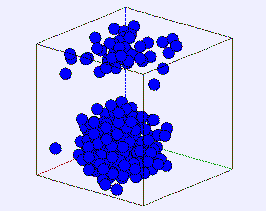

We finish the first half of the semester by studying how molecular dynamics models based on classical mechanics give rise to macroscopic phenomena. Students turn in their mid-term projects at the end of the week.
The Lennard Jones 3D Molecular Dynamics Model extends 2D Lennard-Jones models to 3D. This new model assumes periodic boundary conditions because these conditions are a better approximation for an infinite system than hard walls.
In order to create as simple a model as possible, all parameters except the time step dt are hard-coded into the model. For sufficiently small time steps dt, the system's total energy should be approximately conserved. Reduce the time step if the energy drifts or if the system becomes unstable.
See the related 2D Lennard-Jones Molecular Dynamics model for a simulation with walls and adjustable parameters.
The following models use the Lennard-Jones potential to model molecular dynamics.
Additional models may be be posted for self-study.
The Lennard-Jones 3D Molecular Dynamics Model was created for teaching computer modeling by Wolfgang Christian using the Easy Java Simulations (EJS) version 4.1 authoring and modeling tool. You can examine and modify a compiled EJS model if you run the model (double click on the model's jar file), right-click within a plot, and select "Open Ejs Model" from the pop-up menu. You must, of course, have EJS installed on your computer.
Information about Ejs is available at: <http://www.um.es/fem/Ejs/> and in the OSP comPADRE collection <http://www.compadre.org/OSP/>.